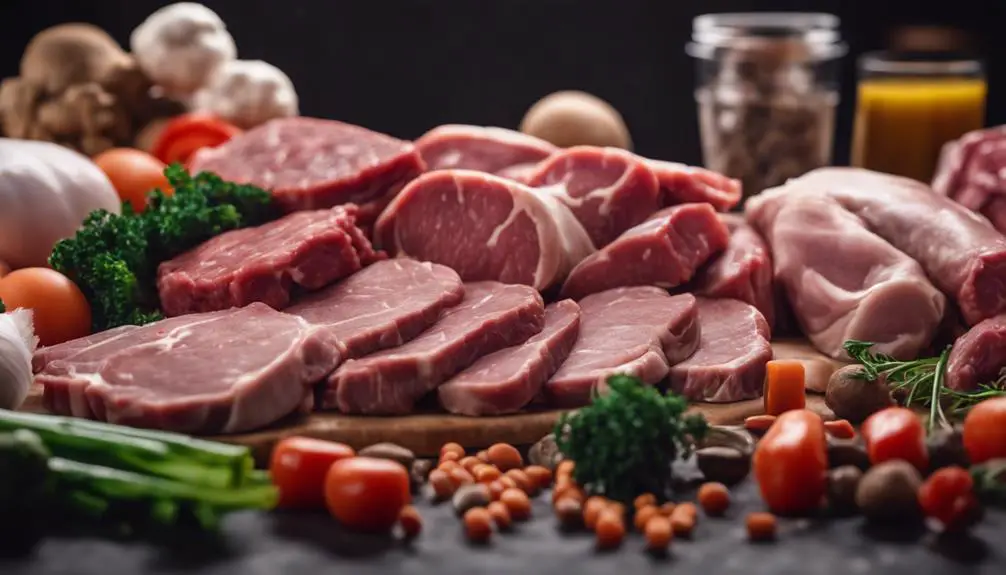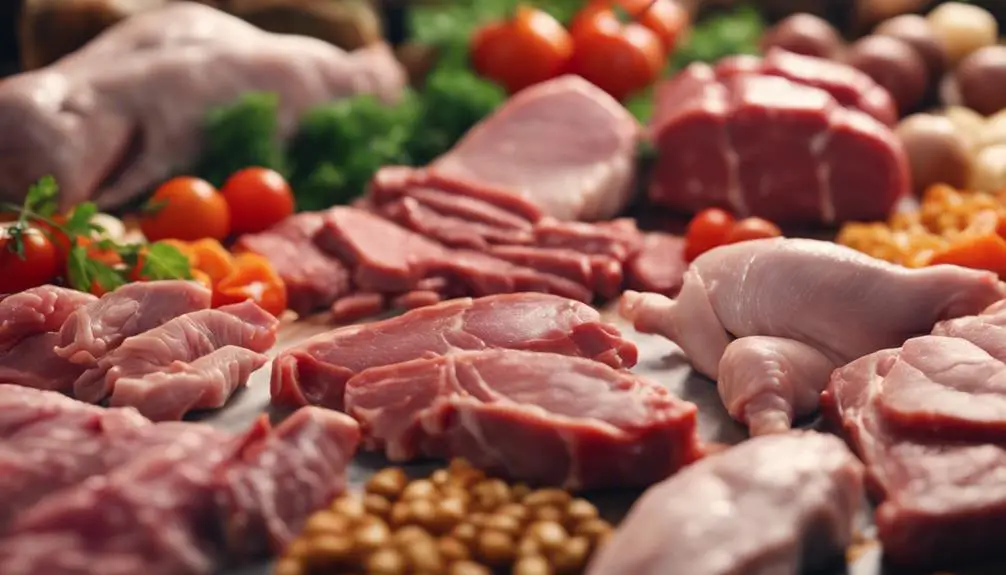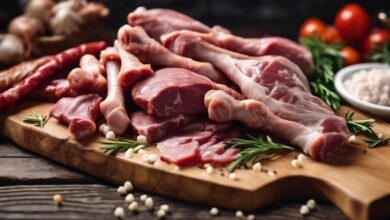What Meat Can Dogs Eat Raw
When feeding raw meat to your dog, choose fresh, high-quality options like beef, chicken, turkey, lamb, pork, or fish. These meats provide essential nutrients and safeguard your pet's safety. Consuming raw meat can offer benefits such as improved digestion, healthier skin and coat, increased energy levels, weight management, and a stronger immune system. Remember to handle raw meat properly to prevent any mishaps and prioritize food safety. Exploring the nutritional value and safety precautions involved in raw meat consumption can help you make informed choices for your furry friend's well-being.
Key Takeaways
- Dogs can eat raw beef, chicken, turkey, lamb, pork, and fish.
- Choose fresh, high-quality meats for safety and nutritional benefits.
- Raw meat provides essential nutrients for dogs' health and vitality.
- Ensure proper handling and hygiene to prevent foodborne illnesses.
- Consult a veterinarian for guidance on a balanced raw meat diet.
Benefits of Raw Meat Diet

When considering a raw meat diet for your dog, understanding the benefits is crucial. Introducing your dog to a raw meat diet can offer numerous health advantages such as improved digestion, healthier skin and coat, increased energy levels, and better weight management. The adjustment process involves gradually incorporating raw meat into your dog's diet to allow their digestive system to adapt. Health benefits of a raw meat diet include reduced allergies, stronger immune system, cleaner teeth, and fresher breath. It is important to note that a properly balanced raw meat diet can provide essential nutrients that may be lacking in commercial dog food. By understanding the health benefits and following a proper adjustment process, you can ensure your dog thrives on a raw meat diet.
Safe Raw Meat Options
When contemplating safe raw meat options for your dog, it's important to explore different types of raw meats that can be included in their diet. Understanding the benefits of a raw meat diet and being mindful of precautions for raw feeding are vital aspects to ponder for your pet's health and well-being. Incorporating a variety of raw meats into your dog's diet can provide them with essential nutrients while ensuring a balanced and wholesome meal plan.
Types of Raw Meats
A variety of safe raw meat options is available for dogs to consume. When considering meat selection for your furry friend's raw diet, it is crucial to prioritize food safety. Opt for fresh, high-quality meats from reputable sources to minimize the risk of bacterial contamination. Some popular choices include beef, chicken, turkey, lamb, pork, and fish. These meats provide essential nutrients like protein, vitamins, and minerals that are beneficial for your dog's health. Remember to handle raw meat properly to prevent cross-contamination and make sure it is stored at the correct temperature. By being mindful of meat selection and following food safety guidelines, you can provide a wholesome and balanced raw diet for your canine companion.
Benefits of Raw Diet
For a dog's best health, incorporating safe raw meat options into their diet offers numerous benefits. Raw diets can provide health benefits such as improved digestion, healthier skin and coat, increased energy levels, and better weight management. Introducing your dog to a raw diet should be done gradually to prevent digestive upsets. Start by introducing small amounts of raw meat mixed with your dog's current food, then slowly increase the ratio of raw meat over time. It's crucial to make sure that the raw meat you choose is fresh, of high quality, and sourced from reputable suppliers to minimize the risk of contamination. By following proper adjustment tips and selecting safe raw meat options, you can help your dog thrive on a raw diet.
Precautions for Raw Feeding
To guarantee the safety of raw feeding for your dog, choosing appropriate raw meat options is crucial for their health and well-being. When it comes to handling precautions and storage, always make sure that raw meat is stored separately from other foods in the refrigerator to prevent cross-contamination. Additionally, remember to wash your hands, utensils, and surfaces thoroughly after handling raw meat. When sourcing raw meat, prioritize quality by selecting fresh, human-grade meat from reputable suppliers to minimize the risk of bacterial contamination. By following these precautions and being mindful of the sourcing and quality of raw meat, you can provide your dog with a safe and balanced raw diet.
| Handling Precautions | Storage |
|---|---|
| Wash hands | Store separately |
| Clean utensils | Refrigerate |
| Sanitize surfaces | Use within days |
| Avoid cross-contamination | |
| Quality sourcing |
Nutritional Value of Raw Meat
When considering the nutritional value of raw meat for your dog, it's important to understand the benefits it offers. Raw meat is rich in protein, essential for your dog's muscle development and overall health. Additionally, raw meat is highly digestible, making it easier for your dog to absorb the nutrients it provides.
Raw Meat Benefits
Raw meat offers dogs essential nutrients that are beneficial for their overall health and well-being. When considering a raw diet for your canine companion, the health benefits of raw feeding cannot be overlooked. Here are some key advantages of incorporating raw meat into your dog's diet:
- Bioavailable Nutrients: Raw meat provides dogs with easily digestible nutrients such as protein, vitamins, and minerals, promoting peak health and vitality.
- Healthy Fats: Raw meat contains essential fatty acids that support your dog's skin, coat, and overall immune function.
- Enzymes and Probiotics: Raw meat includes natural enzymes and beneficial bacteria that aid in digestion and contribute to a healthy gut microbiome, essential for canine nutrition.
Protein in Raw Meat
Incorporating raw meat into your dog's diet provides a rich source of high-quality protein essential for their overall health and well-being. Raw meat benefits your canine companion by offering protein sources that are more akin to what their ancestors would have consumed in their natural diet. Protein is crucial for dogs as it supports their muscle development, immune system function, and overall energy levels. The amino acids found in raw meat help in tissue repair and contribute to a healthy coat and skin. By including raw meat in your dog's diet, you are providing them with a nutritionally dense food that aligns with their biological needs, promoting their overall well-being and vitality.
Digestibility of Raw Meat
For ideal digestion and absorption of essential nutrients, raw meat provides a highly digestible source of protein for your canine companion. When comparing the digestibility of raw versus cooked meat for dogs, raw meat is easier for your pet to digest due to its natural enzymes that aid in the breakdown of proteins. Additionally, raw meat retains more of its nutrients compared to cooked meat, ensuring that your dog receives a higher concentration of essential vitamins and minerals. This increased nutrient retention in raw meat can contribute to better overall health and vigor for your furry friend. So, the next time you're considering your dog's diet, raw meat can be a valuable addition to promote efficient digestion and nutrient absorption.
Risks of Feeding Raw Meat
Feeding your dog raw meat poses potential health hazards that should not be ignored. While raw meat can provide essential nutrients, there are risks associated with this diet. Here are some precautions to keep in mind:
| Risks of Feeding Raw Meat | |
|---|---|
| Bacterial Contamination | Raw meat can contain harmful bacteria like Salmonella and E. coli, leading to foodborne illnesses in dogs. |
| Nutritional Imbalance | A diet solely based on raw meat may lack essential nutrients, such as calcium and fiber, necessary for your dog's overall health. |
| Potential Choking Hazard | Bones in raw meat can splinter or cause obstructions, posing a risk of choking or internal injuries to your dog. |
Preparation Tips for Raw Meat

When preparing raw meat for your dog's diet, make sure that you follow proper hygiene practices to minimize the risk of bacterial contamination. To guarantee the safety of your pet, consider the following tips:
- Meat cutting: Use separate cutting boards and utensils for raw meat to prevent cross-contamination with other foods.
- Food safety: Store raw meat appropriately in the refrigerator or freezer to maintain freshness and prevent bacterial growth.
- Clean preparation area: Thoroughly clean and disinfect any surfaces that come into contact with raw meat to avoid the spread of harmful bacteria.
Transitioning to Raw Meat Diet
When shifting your pet to a raw meat diet, make sure to gradually change to prevent digestive upset and allow their system to adapt to the new food. Shifting tips for raw feeding include starting with a small amount of raw meat mixed with their regular food and then increasing the raw portion while decreasing the kibble over a period of 7-10 days. This gradual shift helps prevent gastrointestinal issues and allows your dog's digestive system to adjust to the raw diet. It is essential to monitor your pet during this process for any signs of discomfort or digestive upset. Remember, shifting to a raw diet can offer various health benefits for your furry friend, including improved digestion, healthier skin, coat, and overall well-being.

If Richie Bedard is a dog food expert, author, or any other figure in the field of dog nutrition that emerged after September 2021,






